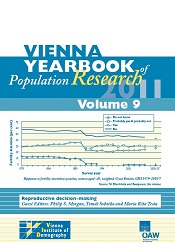 |
Vienna Yearbook of Population Research 2011
|
 |
Verlag der Österreichischen Akademie der Wissenschaften Austrian Academy of Sciences Press
A-1011 Wien, Dr. Ignaz Seipel-Platz 2
Tel. +43-1-515 81/DW 3420, Fax +43-1-515 81/DW 3400 https://verlag.oeaw.ac.at, e-mail: verlag@oeaw.ac.at |
|
||||||||||||||||||||
|
DATUM, UNTERSCHRIFT / DATE, SIGNATURE
BANK AUSTRIA CREDITANSTALT, WIEN (IBAN AT04 1100 0006 2280 0100, BIC BKAUATWW), DEUTSCHE BANK MÜNCHEN (IBAN DE16 7007 0024 0238 8270 00, BIC DEUTDEDBMUC)
|

Vienna Yearbook of Population Research 2011, pp. 227-258, 2012/02/02
doi: 10.1553/populationyearbook2011s227

Over the last decades the majority of European countries have witnessed fertility levels considerably below replacement. Particularly completed cohort fertility below two children per woman has raised concerns whether this trend corresponds to a decline of fertility intentions or represents a discrepancy between intended and realised fertility. Using data from the Fertility and Family Survey (FFS) conducted in 1991, we look at fertility intentions of women aged 20-39 in Flanders, documenting how intentions differ in terms of education of women and their partners, activity status and household position. For a larger group of women, we subsequently compare the effects of these characteristics on first-, second- and third-birth hazards in a prospective study based on longitudinal microdata from the 1991 and 2001 Belgian censuses. Our results indicate that lifetime fertility intentions in 1991 were above the replacement level, but also that the proportion of women having a child in the three-year period following the 1991 census is lower than the short-term intentions suggested in the FFS, particularly for first births. We find evidence of a positive educational gradient in both fertility intentions and birth hazards. For the highly educated, higher birth hazards are associated with a stronger attachment to the labour market (both before and after parenthood), homogamy to highly educated partners and more frequent uptake of (in)formal child care.
Published Online: 2012/02/02 15:32:08
Object Identifier: 0xc1aa5572 0x002a70fd
Document viewed: Calculating...
Rights: All rights reserved. For questions regarding copyright and copies please contact us by email.
